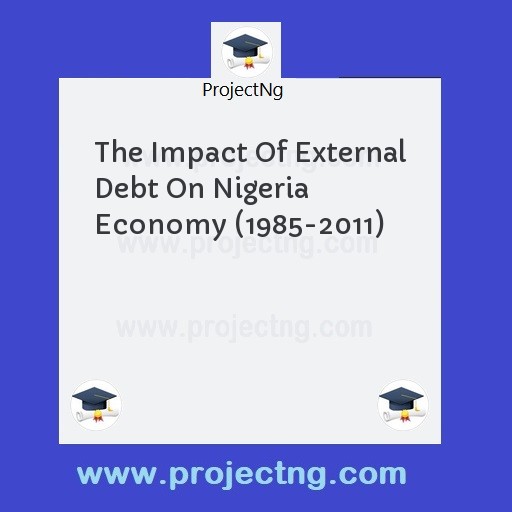The Impact Of External Debt On Nigeria Economy (1985-2011)
Economics Project Topics
Get the Complete Project Materials Now! »
THE IMPACT OF EXTERNAL DEBT ON NIGERIA ECONOMY (1985-2011)
CHAPTER ONE
1.1 BACKGROUND OF STUDY
Most economic development literature described the 1950‘s and 1960‘s as ―Golden Years‖, which marked the rate of development in developing countries whose development at the period was just high and internally generated. Also, the less developed countries (LDCs) increased their investment with little or no reliance on external resources (Daily Sun; 2007).
On the contrary, most of the development experienced in 70‘s was ―debt led‖. This was a result that these countries maintain persistent current account deficits, which led to the borrowing from the international money and capital market to finance projects. Based on this premise, external borrowing has always been resorted to because of the shortfall between domestic savings, seeking external funds to bridge gaps is not desirable which is so because external debts acts as a major constraints to capital formation in developing nations.
In most cases, debt accumulates because of the servicing, requirements and the principal itself. Considering the above, external debt becomes a self-perpetuating mechanism of poverty aggression, over exploitation
2
and a constraint on development in developing countries (NakatamianhHerca; 2007). However like most developing countries of the world; Nigeria relies substantially on external funds for financing its development projects, e.g. Iron and steel mills, roads, electricity generation, plants etc. such external funding usually takes the form of external loans. In the early years of political independence(i.e. 1960 through 1975), the size of such loans was small, the rate of interest concessionary, the maturitywas long-term and the source was usually multilateral in nature. For instance, Nigeria‘s external debt in 1960 was about $150million, however, beginning in the year 1978, the situation changed. Nigeria, at the lure of the international financial institutions started to borrow huge sums from private sources at a floating rates and with shorter term maturities (Business New; 2009).
In 1978 ―JomboLoan‖alone which is borrowed from the international capital market (ICM) was estimated to sum of $1billion which represented over 100% of Nigerians Gross Domestic Product (GDP) for that year. The situation precipitated a debt-crisis that progressively worsened overtime. However, it follows that debt is an integral part of all economies; developed, developing or undeveloped. (Bannock Baxter and Rees, 1972). By 1986, Nigeria had to adopt a
3
WorldBank/International Monetary Fund (IMF) sponsored Structural Adjustment Programme (SAP), with a view to revamping the economy and making the country better-able to service her debt.
Furthermore some state government resorted to imprudent borrowings from external source. This was to finance all sorts of projects of doubtful viability. Sooner than expected, the debt problem was marked to have started in the 1980‘s. in fact, the external debt escalatedfrom #8,8194million in 1982 through to #10,577.7millionin 1985. In 1987, it was #100,787.6million. it further moved up to #328,051million and #633,144.4million between 1991 and 1993 respectively. By 1995 and 1996, Nigeria had an outstanding debt of #716,865.6millionand #617,329.0million respectively (CBN statistical bulletin, 2004). In Nigeria, the debtsituation is really a big problem because these debts mount are accumulated annually and we find that the more debt we accumulate, the higher the debt services payment and less resource. This in turn reduces savings for investment purposes. Such a situation portrays an imminent danger for the present and future of the country. This study therefore tends to focus on the impact of external debt on Nigeria economy and also provides lasting solution to external debt problems.
4
1.2 STATEMENT OF PROBLEM
Nigeria which was a net lender to organisations like IBRD, IMF, Paris Club etc. is today one of the highly indebted countries to these organisations. External debt when effectively and efficiently utilized is meant to provide some investments. The returns from these investments will be used in the settlement of the debt. But in Nigeria, the reverse is the case. The debt is incurred to service and enrich the private pockets of our leaders,on behalf of the entire citizenry(Vanguard; 2004). Consequently upon this, debt servicing has become one of the most consuming elements of Nigeria‘s annual earnings. The Nigeria‘s unfavourable balance of payment (BOP) istoday a function of some variables amongst which external borrowing is rated the most influential factor. The BOP problem in turn leads to high rate of inflation, import and dependence. Nigeria‘s external debt has no doubt put pressure on the economic recovery and growth of the country. This research has actual impact of the external debt on the economy of Nigeria.
The trend of external debt shows the state of the economy considering the external debt. Thus, it shows whether the external debt of the Nigerian economy is increasing or decreasing. As at 1990 to 1992, the external debt amounted to 82.3% and from 1993 to 1995, it decreased
5
significantly by 13.2% while from 1996 to 1998, it further decreased by 2.5%. As at 1999 to 2001, the Nigeria external debt was insignificant. But as at 2002 to 2004 there was a significant increase on the Nigeria external debt by24.3%, while from 2005 to 2007 the external debt was insignificant. But 2008 to 2010 showed an increase in the Nigeria external debt by 39.9%.
Be the First to Share On Social

Enjoying our content?
Don't miss out on new videos! Subscribe to our YouTube channel for more awesome content.
Subscribe Now!













